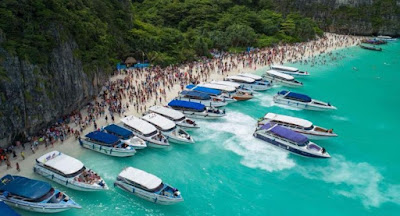If you’re looking for a laid-back escape with an adventure or two, it
would be hard to beat Lombok and the Gili Islands. You can choose to
relax on endless white sand beaches, dive remote coral reefs or hike to
see panoramic views.
Devastated by the series of earthquakes in 2018, these destinations
are bouncing back and hungry for tourists. So pack your bags this coming
dry season and go explore paradise.
1. Hike Mount Rinjani National Park
Lombok's Mount Rinjani National Park is unbeatable for spectacular
views and challenging trails. While most of the hiking trails on Mt.
Rinjani were damaged in the 2018 earthquakes, one trail has reopened.
Located in Aik Berik village, the trail is lesser known among the
mountain's more popular trails, but offers a similar experience for
adventurous travelers in search of epic views.
2. Hop around Gili Islands
For a relaxing break from daily life, consider going island-hopping
around the stunning Gili Islands. These islands are known for scuba diving cruises and offers a chance to truly get away from it all.
If you can bear to tear yourself away from the white sand beaches and
turquoise ocean vistas, you’ll find vibrant coral reefs teeming with
life under the waters.
The Shark Point dive site offers a chance to dive with sharks and
manta rays, while Deep Turbo offers overhangs and underwater caves for
experienced divers to explore. You might even see a whale shark or two.
.
.
3. Experience Bangkang bat cave
A trip to Goa Bangkang will take your breath away with stalactites
and bursts of sunlight through the cave's ceiling. Tucked underground on
Lombok, it is a cave like no other.
Descending the stairs into Bangkang, your senses will be struck by
the sound and smell of thousands of bats. If you stay in the area until
sunset, you can watch the bats exit the cave, covering the sky as they
begin their nightly hunt for food.
4. Swim with sea turtles
If you’re a fan of sea turtles (who isn’t?), be sure to check out the sea turtle conservation initiatives at the Gili Islands.
Green sea turtles, which are classified as endangered, are
well cared for at Gili Meno, thanks to Bolong, the local man who set up
the Gili Meno Turtle Sanctuary. The sanctuary saves turtle eggs from
predators to help release the precious hatchlings into the sea.
The sanctuary is fascinating, and your visit will support turtle
conservation, as it depends entirely on donations from visitors.
You can swim with sea turtles at various spots around the Gili
Islands. Gili Air is especially known for green sea turtles at Han Rock.
5. Slow down, enjoy the silence
No motorized vehicles are allowed on Gili Trawangan, meaning you can
escape the noise of the neighboring destinations and rejuvenate in peace
and quiet.
The best way to explore the charms of Gili Trawangan is by foot or on
a bicycle. Stop off at beach bars, do some yoga, or just walk the
endless sands to reconnect with yourself, one day at a time.
6. Enjoy epic views from Gili Trawangan
There’s only one lookout point on the Gili Islands, at the top of
Gili Trawangan. Head off on a hike at sunrise, and you’ll start your day
off right.
At the peak is a shrine and Muslim burial site, plus the remains of a
World War II Japanese bunker to investigate, though the view is the
real highlight.
Resting at the top, you can look across the ocean to Mt. Rinjani and
capture panoramic views of the other Gili Islands, plus Lombok and Bali.
7. Learn to dive at Sekotong
If you’ve always wanted to try scuba diving but were too nervous to
take the plunge, Sekotong in Lombok is a great place to start. The
beautiful reefs there offer easy, sheltered dives, perfect for
beginners.
It will be well worth the effort, as you’re likely to spot sea turtles. You can even try spotting the tiny pygmy seahorses.
8. Watch the sunset at Semeti Beach
Another Lombok highlight are the rock formations on Semeti Beach,
which are not to be missed. These striking pyramid-shaped rocks jut
impressively out of the ocean, providing the perfect backdrop to a
sunset.
Semeti Beach is an ideal place to end a day of island-hopping, to see
the best view of the sun setting that you’re ever likely to see.
Source - TheJakartaPost



























